On a trip to the Silk Road (China, the Five Stans, and Azerbaijan) in September and October, 2017, we had what we thought was a six-hour layover in Hong Kong after a flight from LAX that covered 7,288 miles in a little over fourteen hours.
My husband and I decided that sitting around for six hours waiting for our second flight was too much to bear after such a long first flight, so we began exploring the idea of a quick trip away from the airport. We read conflicting comments on Trip Advisor about whether or not it was wise to leave the airport, and in the end we decided to go for it. When we landed at 7:00 AM and discovered that we had SEVEN hours, not six, we felt even more comfortable with the decision.
The Hong Kong International Airport itself is pretty unique. For starters, I liked this mother and child bathroom stall:
You can take a shower here before your business meeting:
There is a pink pagoda in the middle of the airport:
And the airport design is tres chic:
Our friends John and Susan decided to check their carry-ons in the "Left Baggage" facility, for which they paid a small fee. (Bob and I kept our backpacks.) Getting off the plane, going through immigration, and finding this desk took less than an hour.
We caught a cab outside and asked the driver to take us to the tram that goes to the "Big Buddha," the closest attraction to the airport. A few minutes into the ride, we were wondering what we had gotten ourselves into. First of all, the steering wheels in Hong Kong are on the right side of the car, which is disconcerting by itself, but then the driver thought he was Al Unser and drove like the road was the Indy 500. Luckily there wasn't a lot of traffic, and after about 15 minutes in his cab, we were more than happy to disembark.
However, we discovered that the tram didn't open for an hour, so we had some time to kill. We discovered a shopping area a few blocks from the tram and found some interesting things to look at:
"Molten egg yolk custard" I get, but what is "Ball law cowssant"?
We always enjoy grocery stores, and Hong Kong had a great one near the tram. This open butcher area was in the center of the store and included women butchers along with the men. I wish I had a video of their flying hands:
There were all kinds of good things to eat, such as Lo Sui Pork Ear . . .
. . . dozens of varieties of mushrooms:
. . . and fresh fish--choose the one you want, and they will kill it and filet it for you:
We came back to the tram about 15 minutes early, but the line (which was non-existent when we got there) was already quite long. Once the tram opened, however, the line moved quickly:
It took us 25 minutes to travel the 3.5 miles to the top of the mountain, a journey that takes an hour by car, a much less enjoyable method of travel.
The view ahead was of lush, verdant mountains:
Down below we could see the old wooden steps that used to be the only way to access Po Lin Monastery. It was very hot and very humid, and I was very relieved that we were not taking the stairs:
At 112 feet tall, he's kinda hard to miss:
However, to get to him we had to go through the requisite tourist shops and frou-frou:
. . . and then through this venerable Chinese gate:
. . . past the Twelve Divine Generals (here are two):
. . . past the fancy courtyard:
. . . and up 268 steps to reach the ancient bronze figure (created in 1993):
Note the swastika on his chest. The word "swastika" in Sanskrit means "it is good" or "all is well." Buddhists were using the swastika as a symbol of peace and harmony long before Hitler pilfered and corrupted it:
Six smaller bronze statues surround Big Buddha. Each is offering something to him: flowers, incense, light, ointment, fruit, or music. Each gift symbolizes one of the Six Perfections Necessary for Enlightenment: generosity, morality, patience, zeal, meditation, and wisdom.
Going down the stairs was much more fun than going up:
The line to get on the tram was also much shorter at the top than it had been down below:
In no time at all we were back at sea level:
We got back in a cab (with a much saner driver) and returned to the airport with several hours to spare. In fact, we had time to eat a meal at Hung's Delicacies, a restaurant in the airport that has actually earned a Michelin Star three years in a row. I never thought my first meal at a Michelin-rated restaurant would be in an airport.
I had Chinese-marinated goose slices:
Bob had pork belly, goose kidneys, and pork intestines in aspic:
My husband and I decided that sitting around for six hours waiting for our second flight was too much to bear after such a long first flight, so we began exploring the idea of a quick trip away from the airport. We read conflicting comments on Trip Advisor about whether or not it was wise to leave the airport, and in the end we decided to go for it. When we landed at 7:00 AM and discovered that we had SEVEN hours, not six, we felt even more comfortable with the decision.
The Hong Kong International Airport itself is pretty unique. For starters, I liked this mother and child bathroom stall:
You can take a shower here before your business meeting:
There is a pink pagoda in the middle of the airport:
And the airport design is tres chic:
Our friends John and Susan decided to check their carry-ons in the "Left Baggage" facility, for which they paid a small fee. (Bob and I kept our backpacks.) Getting off the plane, going through immigration, and finding this desk took less than an hour.
We caught a cab outside and asked the driver to take us to the tram that goes to the "Big Buddha," the closest attraction to the airport. A few minutes into the ride, we were wondering what we had gotten ourselves into. First of all, the steering wheels in Hong Kong are on the right side of the car, which is disconcerting by itself, but then the driver thought he was Al Unser and drove like the road was the Indy 500. Luckily there wasn't a lot of traffic, and after about 15 minutes in his cab, we were more than happy to disembark.
"Molten egg yolk custard" I get, but what is "Ball law cowssant"?
We always enjoy grocery stores, and Hong Kong had a great one near the tram. This open butcher area was in the center of the store and included women butchers along with the men. I wish I had a video of their flying hands:
There were all kinds of good things to eat, such as Lo Sui Pork Ear . . .
. . . fresh pork "trotter" (feet):
. . . dozens of varieties of mushrooms:
. . . and fresh fish--choose the one you want, and they will kill it and filet it for you:
We came back to the tram about 15 minutes early, but the line (which was non-existent when we got there) was already quite long. Once the tram opened, however, the line moved quickly:
It took us 25 minutes to travel the 3.5 miles to the top of the mountain, a journey that takes an hour by car, a much less enjoyable method of travel.
Below us we could see some of the high rises at the end of the bay:
The view ahead was of lush, verdant mountains:
Down below we could see the old wooden steps that used to be the only way to access Po Lin Monastery. It was very hot and very humid, and I was very relieved that we were not taking the stairs:
As we neared the top, we could see the Tian Tan Buddha, known by everyone--even locals--as "Big Buddha":
At 112 feet tall, he's kinda hard to miss:
. . . and up 268 steps to reach the ancient bronze figure (created in 1993):
Well, HELLO!
Note the swastika on his chest. The word "swastika" in Sanskrit means "it is good" or "all is well." Buddhists were using the swastika as a symbol of peace and harmony long before Hitler pilfered and corrupted it:
It is a little difficult to get a good shot of Big Buddha. The stairs are steep and he is, well, BIG. He is sitting on top of a three-platform altar topped with a lotus leaf. Here are views of Big Buddha's front side and back side:
Six smaller bronze statues surround Big Buddha. Each is offering something to him: flowers, incense, light, ointment, fruit, or music. Each gift symbolizes one of the Six Perfections Necessary for Enlightenment: generosity, morality, patience, zeal, meditation, and wisdom.
Close-up view of two of the statues:
The curled roof of the Po Lin Monastery, founded in 1906, can be seen nearby:
Going down the stairs was much more fun than going up:
The line to get on the tram was also much shorter at the top than it had been down below:
We got back in a cab (with a much saner driver) and returned to the airport with several hours to spare. In fact, we had time to eat a meal at Hung's Delicacies, a restaurant in the airport that has actually earned a Michelin Star three years in a row. I never thought my first meal at a Michelin-rated restaurant would be in an airport.
Bob had pork belly, goose kidneys, and pork intestines in aspic:
It was good, but not Michelin good.
Overall, we were SO glad that we used our seven-hour layover to see some sites. The tram is close to the airport--so close that we could see it from one of the airport windows. I suppose really bad traffic, which we did not have, might delay the taxis, but it's hard to imagine a scenario where a trip to Big Buddha would not be feasible during even a five-hour layover.










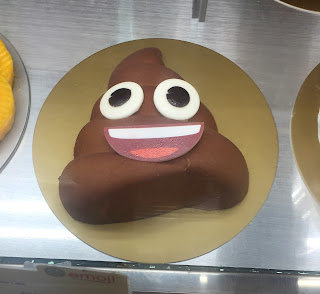
















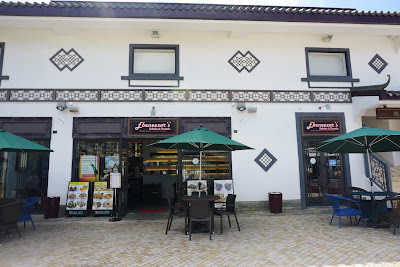




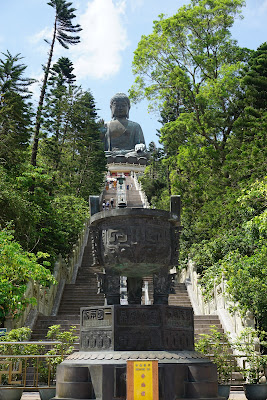



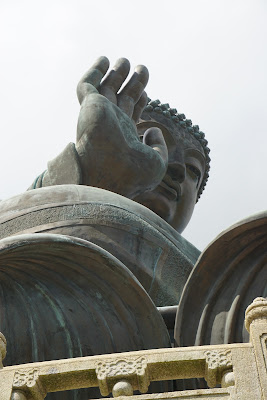





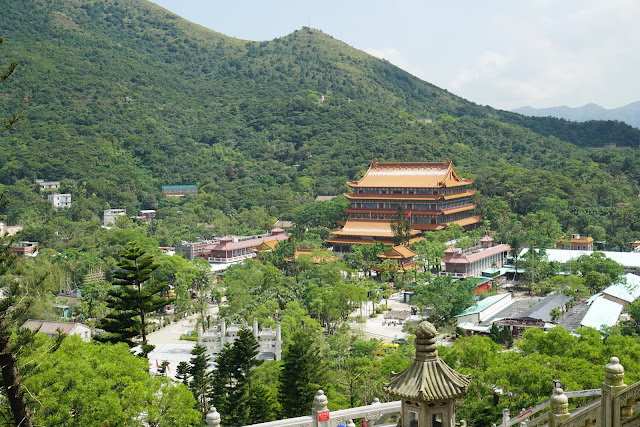




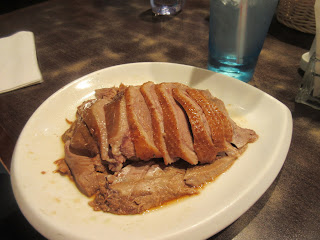

It was a very good decision to get out of the airport in Hong Kong. The tram ride and Big Buddha would be worth doing any time, even better when you are killing time during a layover. Also very fun to have a nice restaurant in the airport, even if the food was not Michelin quality. It was interesting and good. A nice beginning to our trip.
ReplyDeleteAwesome use of layover time.
ReplyDelete